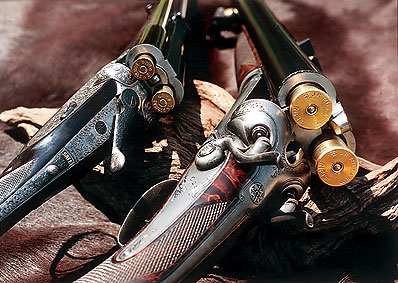|
 |
| A 500/465 Nitro Express Holland & Holland compared to a 4-bore. |
The building of a double rifle is not a project to embark on without doing a lot of preparation. To choose the 4-Bore double would compound the task greatly as just gathering data on them - the rarest of all the firearms used in my favourite time period - would prove to be a monumental task. Tracking down the existing few that have survived and gaining access to them was time-consuming, but I met many interesting and knowledgeable people on this quest. Many hours would be spent on this project between October 1985, when it started to take shape on paper, to September 1998 when I carried it in the Zimbabwe bush. At the time I started on this, my wife, Jan and myself, operated a machine shop in Whitehorse, Yukon Territory, Canada, which is probably as far from Unit One Matetsi as you can get on this planet. I began by machining out lead bullets of varying diameters and shapes and comparing them to pictures in old ammo catalogues.
The so-called 4-Bore’s bullet diameters varied widely in the cartridge versions usually around .935 to .955 with the true one inch size normally found only in the old muzzle loading rifles. The 4-Bore size being an old reference measurement of 4-Balls to the pound of lead, which computes out to 1750 grains of weight. The cartridge rifles usually fired projectiles weighing around 1850 grains. I settled on a bullet diameter of .962, a weight of 1600 to 1850 grains and a case length of four and one quarter inches, which were the dimensions of Holland and Holland’s one and only Nitro loaded 4-Bore that they built for a Maharajah. The barrel tooling was made up and the bores cut to 12 grooves one turn in 66 inches. Brass cartridge cases were machined from solid stock, a bullet-mould cut out and a heavy steel test jig was fabricated. It was now January 1988, and on a mild 25 Degrees Fahrenheit day in the far north when we packed all this rigging outdoors to touch off a few rounds. Over the next six months, many pounds of powder and lead were consumed in testing and gathering data on 4-Bore cartridge loads. The general opinion seems to be that, “Those old cannons weren’t accurate... they just made a lot of noise”. Very early in testing loads (through a 110 lb fixture that slid on a steel-plate, two and half feet during recoil) it was obvious that excellent groups were possible with the right components and loadings. The best groups obtained during these bench tests, measured one and half inches centre to centre, five shots at 50 metres.
The big question was still unanswered, could this be built into a rifle and could you come close to accuracy when the human factor, the weight of the gun, and the recoil were brought into the picture? At this point, I had yet to handle a real 4-Bore or talk to anyone who had actually fired this calibre double rifle. Even the gun writers show photos of the 4’s, but fire the 8’s in their articles, limiting the 4’s to the photo shoot session. The 8-Bore double rifle was the largest calibre to date that I had handled and fired. My own 8B Rodda .850 diameter bullet and my friend Neil Cross’s Tolley, .890 diameter, both three and one quarter inch cases. So with these guns available for dimensional references to scale up from, I was able to continue on with receiver machining and start barrel contouring until the time that I was able to gain access to a real 4B to get all those subtle little details sketched out on paper so that my gun would look like the real thing.
|